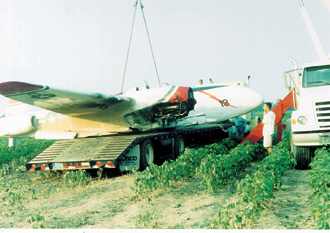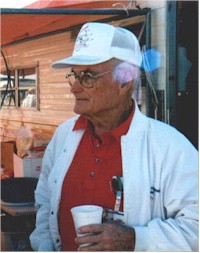White Lightnin' Crash
News Coverage
Following are the details we have as provided by P‑38 Members, Art Heiden and Steve Blake.
Lefty Gardner's White Lightnin'
Down in Mississippi
Photo by Bobby Thompson
 On Monday afternoon, at the Greenwood-LeFlore (MS) airport, the sound of an Allison V12 overhead must have gotten some to look into the sky. The problem was that the airplane they were watching was 25Yankee, a Lockheed P38L, which usually has two such engines. Ladd Gardner, son of "Lefty" Gardner, was making an emergency landing just west of the airport.
On Monday afternoon, at the Greenwood-LeFlore (MS) airport, the sound of an Allison V12 overhead must have gotten some to look into the sky. The problem was that the airplane they were watching was 25Yankee, a Lockheed P38L, which usually has two such engines. Ladd Gardner, son of "Lefty" Gardner, was making an emergency landing just west of the airport.
He had reported an engine fire in the port nacelle, and then smoke started filling the cockpit, making it impossible for him to see, as he headed for the welcoming asphalt at GWO.
He had to miss the airport, though; and he landed in a cotton field just west of it. The P38L5LD, famous as unlimited racer White Lightnin', a 1944 manufacture that Gardner has had since the early '60s, belly-flopped in, sustaining serious but repairable damage, and protecting Ladd from harm.
In an exclusive ANN interview, Charles Allen, the airport manager at Greenwood, said Ladd Gardner was quickly running out of time. He brought the airplane in gear-up, Allen told us, and "the airplane is pretty badly damaged. All of the belly under the cockpit is messed up; and on the left side, where the fire was, it looks like it burned into the wing. Both props are gone, too."
[Note: that left-side engine was brand-new at Reno, 1996. Brand-new, as in, "WWII manufacture, new in crate." --ed.]
A call to Al Stone, handling the investigation out of the NTSB office in Atlanta. "They took a flatbed down there, and were able to drop the gear. It's on its gear now. The pilot said they will store it in the Greenwood area for the time being. The latest information is that it's not too badly damaged."
Cecil Womble, in the tower at Greenwood, told us, the day after the P38 arrived, "They pulled the gear down, and it's been backed into a hangar. It took them a while, but it's on its feet. There's a hole, about twice the size of a [dinner] plate, through the left wing, and it was smoldering; but the firemen put a little foam on it -- it's out now. It's just full of dirt, and cotton balls, and more dirt, and leaves..." That dirt may have been good luck for the plane, or even for Ladd. Charles Allen told us, "I think the dirt from the field may have helped put the fire out."
A Bob Darden article on the website of the Greenwood paper, The Commonwealth, (since removed by the paper) said Ladd was flying "Lefty" Gardner's vintage World War II Lockheed P38 "Lightning" fighter plane back home Monday morning from an air show in Tullahoma, Tenn., when the left engine caught fire. As the cabin filled with smoke, Gardner said he tried to head toward Greenwood-Leflore Airport in an effort to make an emergency landing. However, within minutes of the fire breaking out, Gardner said he was forced to crash land..."
Darden relayed some bad news: "...the plane, valued at around $2 million, sustained major damage and could take years to restore, Gardner said." A Mississippi State Trooper who helped get the Lightning back to the airport told us, "That thing's 52 feet long. [Note: it's 52 feet wide when it's flying, but it was placed sideways on the flatbed --ed.] We blocked traffic for a little while. We probably had a lot of folks cussin' us." He was at the right place, at the right time. " I was on the way to the heights, and Kenny (Kenny Carver, the man whose field it landed in) flagged me down."
A man outstanding in his field... Mr. Carver, in an exclusive ANN interview, told us his men watched the Lightning coming in to do its landing. "He didn't have a choice," Carver said. "He had an engine off, and it was on fire. My men saw him come in. He just come down - barely missed one of my tractors. Then there wasn't anything but a big ball of dust." Carver, who was working some distance from the landing site, said, "They called me on the radio, and we brought a water wagon over and put the fire out. He [Gardner] didn't have a scratch on him."
Carver, like most of us, thought the younger Gardner had done a good job of historic aircraft preservation "He did a good job of putting it down and letting it slide," he said. Carver spoke with Ladd briefly after the fire was put out. He related what the pilot told him: "One engine was running when it hit. He said the smoke got so strong in the cabin he couldn't stand it."
Mr. Carver has seen a lot of machinery, and his insights are worth noting. He told us, "It looked like there was a little explosion by the engine. There was dirt all over it, but that one engine was still burning when I got there."
He didn't want the airplane to burn up. "That's when I went to get the water trailer." Carver at first didn't recognize the airplane which had landed in his cotton. "I didn't know what kind of an airplane it was; I just wanted to get that fire out. Then I found out how valuable that airplane was," he said.
Carver's volunteer work didn't end there. "After I got the fire out," he said, "I went to pick up his dad and the crew chief, and somebody else, at the airport. We're about 2 miles from the airport, as the eagle flies.
He [Lefty] was really concerned about his boy. Then he was concerned about the plane."
The Carver farm is somewhat the worse for wear. "Counting all the trampling around, he probably got about 5 acres," of his cotton, Mr. Carver said.
As far as the actual damage the airplane did? "He slid probably 200 yards."
Carver is becoming more familiar with aircraft. This isn't the first time one has landed on his land. It is the first Lightning, though. "I've have a balloon come down," he said;" but never a plane.


